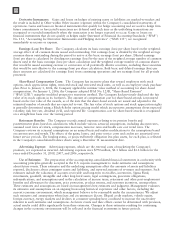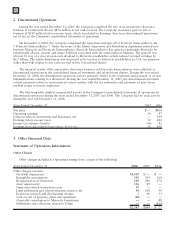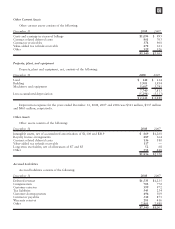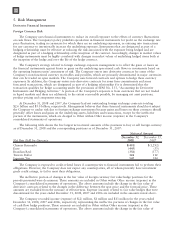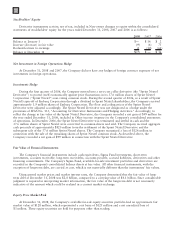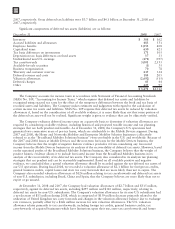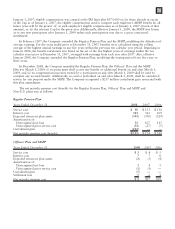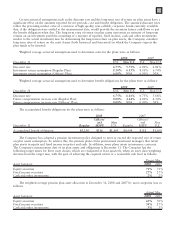Motorola 2008 Annual Report Download - page 108
Download and view the complete annual report
Please find page 108 of the 2008 Motorola annual report below. You can navigate through the pages in the report by either clicking on the pages listed below, or by using the keyword search tool below to find specific information within the annual report.
5. Risk Management
Derivative Financial Instruments
Foreign Currency Risk
The Company uses financial instruments to reduce its overall exposure to the effects of currency fluctuations
on cash flows. The Company’s policy prohibits speculation in financial instruments for profit on the exchange rate
price fluctuation, trading in currencies for which there are no underlying exposures, or entering into transactions
for any currency to intentionally increase the underlying exposure. Instruments that are designated as part of a
hedging relationship must be effective at reducing the risk associated with the exposure being hedged and are
designated as part of a hedging relationship at the inception of the contract. Accordingly, changes in market values
of hedge instruments must be highly correlated with changes in market values of underlying hedged items both at
the inception of the hedge and over the life of the hedge contract.
The Company’s strategy related to foreign exchange exposure management is to offset the gains or losses on
the financial instruments against losses or gains on the underlying operational cash flows or investments based on
the operating business units’ assessment of risk. The Company enters into derivative contracts for some of the
Company’s non-functional currency receivables and payables, which are primarily denominated in major currencies
that can be traded on open markets. The Company uses forward contracts and options to hedge these currency
exposures. In addition, the Company enters into derivative contracts for some firm commitments and some
forecasted transactions, which are designated as part of a hedging relationship if it is determined that the
transaction qualifies for hedge accounting under the provisions of SFAS No. 133, “Accounting for Derivative
Instruments and Hedging Activities.” A portion of the Company’s exposure is from currencies that are not traded
in liquid markets and these are addressed, to the extent reasonably possible, by managing net asset positions,
product pricing and component sourcing.
At December 31, 2008 and 2007, the Company had net outstanding foreign exchange contracts totaling
$2.6 billion and $3.0 billion, respectively. Management believes that these financial instruments should not subject
the Company to undue risk due to foreign exchange movements because gains and losses on these contracts should
generally offset losses and gains on the underlying assets, liabilities and transactions, except for the ineffective
portion of the instruments, which are charged to Other within Other income (expense) in the Company’s
consolidated statements of operations.
The following table shows the five largest net notional amounts of the positions to buy or sell foreign currency
as of December 31, 2008 and the corresponding positions as of December 31, 2007:
Net Buy (Sell) by Currency December 31,
2008
December 31,
2007
Notional Amount
Chinese Renminbi $(481) $(1,292)
Euro (445) (33)
Brazilian Real (356) (377)
Taiwan Dollar 124 112
Japanese Yen 542 384
The Company is exposed to credit-related losses if counterparties to financial instruments fail to perform their
obligations. However, the Company does not expect any counterparties, all of whom presently have investment
grade credit ratings, to fail to meet their obligations.
The ineffective portion of changes in the fair value of foreign currency fair value hedge positions for the
periods presented were de minimis. These amounts are included in Other within Other income (expense) in the
Company’s consolidated statements of operations. The above amounts include the change in the fair value of
derivative contracts related to the changes in the difference between the spot price and the forward price. These
amounts are excluded from the measure of effectiveness. Expense (income) related to fair value hedges that were
discontinued for the years ended December 31, 2008, 2007 and 2006 are included in the amounts noted above.
The Company recorded income (expense) of $(2) million, $1 million and $13 million for the years ended
December 31, 2008, 2007 and 2006, respectively, representing the ineffective portions of changes in the fair value
of cash flow hedge positions. These amounts are included in Other within Other income (expense) in the
Company’s consolidated statements of operations. The above amounts include the change in the fair value of
100


